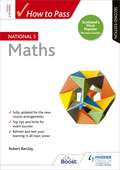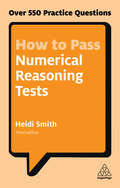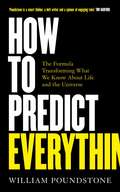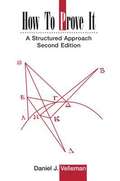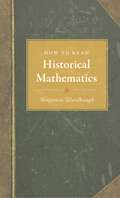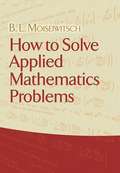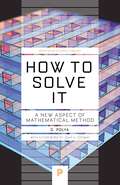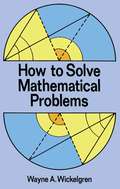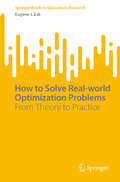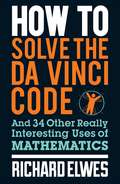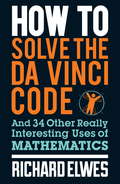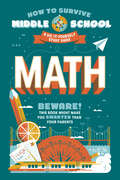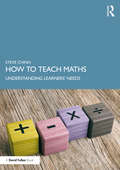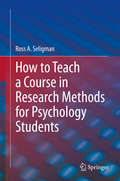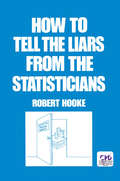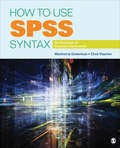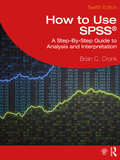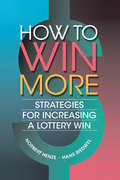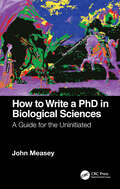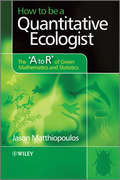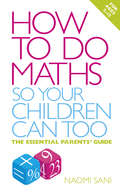- Table View
- List View
How to Pass National 5 Maths, Second Edition: Second Edition Epub
by Robert BarclayExam Board: SQALevel: National 5Subject: MathsFirst teaching: September 2017First exams: Summer 2018Get your best grade with comprehensive course notes and advice from Scotland's top experts, fully updated for the latest changes to the National 5 course specification.How to Pass National 5 Maths, Second Edition contains all the advice and support you need to revise successfully for your National 5 exam. It combines an overview of the course syllabus with advice from a top expert on how to improve exam performance, so you have the best chance of success.> Revise confidently with up-to-date guidance tailored to the latest assessment changes> Refresh your knowledge with comprehensive, tailored subject notes> Prepare for the exam with top tips and hints on revision techniques> Get your best grade with advice on how to gain those vital extra marks
How to Pass Numerical Reasoning Tests: Over 550 Practice Questions
by Heidi SmithContaining the largest bank of test questions on the market, How to Pass Numerical Reasoning Tests provides advice, practice and exercises to help you prepare for the rigorous tests used by employers, helping you to build up speed, accuracy and confidence. An overview of the basics is followed by a step-by-step guide to numerical tests, covering:- Fractions and decimals- Rates- Percentages- Ratios and proportions- Data interpretationAlso containing practice on mathematical problems in written word format to aid your analytical skills, How to Pass Numerical Reasoning Tests gives you everything you need to boost your ability and face the challenge head on.
How to Predict Everything: The Formula Transforming What We Know About Life and the Universe
by William PoundstoneHow do you predict something that has never happened before? There&’s a useful calculation being employed by Wall Street, Silicon Valley and maths professors all over the world, and it predicts that the human species will become extinct in 760 years. Unfortunately, there is disagreement over how to apply the formula, and some argue that we might only have twenty years left. Originally devised by British clergyman Thomas Bayes, the theorem languished in obscurity for two hundred years before being resurrected as the lynchpin of the digital economy. With brief detours into archaeology, philology, and overdue library books, William Poundstone explains how we can use it to predict pretty much anything. What is the chance that there are multiple universes? How long will Hamilton run? Will the US stock market continue to perform as well this century as it has for the last hundred years? And are we really all doomed?
How to Prove It: A Structured Approach
by Daniel J. VellemanProofs play a central role in advanced mathematics and theoretical computer science, yet many students struggle the first time they take a course in which proofs play a significant role. This bestselling text's third edition helps students transition from solving problems to proving theorems by teaching them the techniques needed to read and write proofs. Featuring over 150 new exercises and a new chapter on number theory, this new edition introduces students to the world of advanced mathematics through the mastery of proofs. The book begins with the basic concepts of logic and set theory to familiarize students with the language of mathematics and how it is interpreted. These concepts are used as the basis for an analysis of techniques that can be used to build up complex proofs step by step, using detailed 'scratch work' sections to expose the machinery of proofs about numbers, sets, relations, and functions. Assuming no background beyond standard high school mathematics, this book will be useful to anyone interested in logic and proofs: computer scientists, philosophers, linguists, and, of course, mathematicians.
How to Prove It: A Structured Approach (Second Edition)
by Daniel J. VellemanThis book helps students to develop deductive reasoning ability in general and to learn the underlying principles involved in the construction of proofs by focusing on "structured proving."
How to Read Historical Mathematics
by Benjamin WardhaughTechniques for deciphering texts by early mathematiciansWritings by early mathematicians feature language and notations that are quite different from what we're familiar with today. Sourcebooks on the history of mathematics provide some guidance, but what has been lacking is a guide tailored to the needs of readers approaching these writings for the first time. How to Read Historical Mathematics fills this gap by introducing readers to the analytical questions historians ask when deciphering historical texts.Sampling actual writings from the history of mathematics, Benjamin Wardhaugh reveals the questions that will unlock the meaning and significance of a given text—Who wrote it, why, and for whom? What was its author's intended meaning? How did it reach its present form? Is it original or a translation? Why is it important today? Wardhaugh teaches readers to think about what the original text might have looked like, to consider where and when it was written, and to formulate questions of their own. Readers pick up new skills with each chapter, and gain the confidence and analytical sophistication needed to tackle virtually any text in the history of mathematics.Introduces readers to the methods of textual analysis used by historiansUses actual source material as examplesFeatures boxed summaries, discussion questions, and suggestions for further readingSupplements all major sourcebooks in mathematics historyDesigned for easy referenceIdeal for students and teachers
How to Solve Applied Mathematics Problems
by B. L. MoiseiwitschThis original Dover publication bridges the gap between lectures and practical applications, offering students of mathematics, engineering, and physics the chance to practice solving problems from a wide variety of fields. Topics include vector algebra, kinematics, fluid dynamics, Fourier series, integral equations, wave motion, heat conduction, tensor analysis, relativity, and more. 2011 edition.
How to Solve It: A New Aspect of Mathematical Method (Princeton Science Library #34)
by G. PolyaThe bestselling book that has helped millions of readers solve any problemA must-have guide by eminent mathematician G. Polya, How to Solve It shows anyone in any field how to think straight. In lucid and appealing prose, Polya reveals how the mathematical method of demonstrating a proof or finding an unknown can help you attack any problem that can be reasoned out—from building a bridge to winning a game of anagrams. How to Solve It includes a heuristic dictionary with dozens of entries on how to make problems more manageable—from analogy and induction to the heuristic method of starting with a goal and working backward to something you already know.This disarmingly elementary book explains how to harness curiosity in the classroom, bring the inventive faculties of students into play, and experience the triumph of discovery. But it&’s not just for the classroom. Generations of readers from all walks of life have relished Polya&’s brilliantly deft instructions on stripping away irrelevancies and going straight to the heart of a problem.
How to Solve Mathematical Problems
by Wayne A. WickelgrenIf you've ever tried to solve mathematical problems without any idea how to go about it, this book is for you. It will improve your ability to solve all kinds of mathematical problems whether in mathematics, science, engineering, business, or purely recreational mathematical problems (puzzles, games, etc.).In the pages of this book you'll discover seven indispensable problem-solving techniques: inference, classification of action sequences, state evaluation and hill climbing, subgoals, contradiction, working backward and relations between problems. Based on modern advances in the fields of artificial intelligence and computer simulation of thought, the techniques are taught here by an effective problem-solving methodology. Dr. Wickelgren, formerly a Professor of Psychology at MIT and the University of Oregon, first defines a problem-solving method, then illustrates its application to simple recreational mathematics problems that require no more background than a year of high school algebra and a year of plane geometry. By devoting the majority of the book to such "puzzle" problems, which require less background and information than more advanced mathematics and science problems, the author reaches the widest possible audience. In the final chapter, however, Dr. Wickelgren deals with specific problems from mathematics, science, and engineering. Throughout the book, sample problems illustrate each method and the author has supplied hints and complete solutions.Carefully and clearly written, this indispensable guide will help students in every discipline avoid countless hours of frustration and wasted effort. It is an ideal book for early undergraduate courses in mathematics, physical science, engineering, computer science, economics and other fields that require problem solving. Preface. Introduction. References.Index. 73 line illustrations.
How to Solve Real-world Optimization Problems: From Theory to Practice (SpringerBriefs in Operations Research)
by Eugene J. ZakWritten by an experienced operations research practitioner with a strong applied mathematics background, this book offers practical insights into how to approach optimization problems, how to develop intelligent and efficient mathematical models and algorithms, and how to implement and deliver software products to customers. With a focus on revealing the similarities and differences between academia and industry in mathematical modeling, the book provides useful tips and advice based on the author’s extensive experience as a principal developer working to solve real-world optimization problems for several major high-tech companies.The book offers valuable food for thought for researchers and practical guidance for graduate students preparing for their future projects in the industry. It is also an essential resource for practitioners working in the industrial, business, and service sectors.
How to Solve the Da Vinci Code
by Richard ElwesCan you outrun a bullet? How do you build an electronic brain? Could you slow down time? How do you unleash chaos? From Plato's classification of regular polyhedra to making a million on the stock market, How to Solve the Da Vinci Code gives you everything you need to understand how numbers work, and the impact they have on our lives every day.
How to Solve the Da Vinci Code: And 34 Other Really Interesting Uses of Mathematics
by Richard ElwesCan you outrun a bullet? How do you build an electronic brain? Is it possible to create an unbreakable code? Could you slow down time? How do you unleash chaos? If you thought mathematics was all about measuring angles in a triangle or factorizing equations, think again ... How to Build a Brain and 34 Other Really Interesting Uses of Mathematics demystifies the astonishing world of maths in a series of intriguing, entertaining and often extraordinary scenarios - that explain key concepts in plain and simple language. You'll find out how to unknot your DNA, how to count like a supercomputer and how to become famous for solving mathematics most challenging problem. You'll learn essential survival skills such as how to survive in a whirlpool, how to slay a mathematical monster and how to be alive and dead at the same time. And along the way you'll discover some plain old cool stuff like how to unleash chaos, how to create an unbreakable code and how to use the mathematics to win at roulette or avoid going to prison. So if you want to get to grips with the great questions of number theory and geometry, the mysteries of the prime numbers or Plato's classification of regular polyhedra, or if you are really more interested in learning how to have beautiful children or how to make a million on the stock market, this is the perfect introduction to the fascinating world of modern mathematics.
How to Solve the Da Vinci Code: And 34 Other Really Interesting Uses of Mathematics
by Richard ElwesCan you outrun a bullet? How do you build an electronic brain? Is it possible to create an unbreakable code? Could you slow down time? How do you unleash chaos? If you thought mathematics was all about measuring angles in a triangle or factorizing equations, think again ... How to Build a Brain and 34 Other Really Interesting Uses of Mathematics demystifies the astonishing world of maths in a series of intriguing, entertaining and often extraordinary scenarios - that explain key concepts in plain and simple language. You'll find out how to unknot your DNA, how to count like a supercomputer and how to become famous for solving mathematics most challenging problem. You'll learn essential survival skills such as how to survive in a whirlpool, how to slay a mathematical monster and how to be alive and dead at the same time. And along the way you'll discover some plain old cool stuff like how to unleash chaos, how to create an unbreakable code and how to use the mathematics to win at roulette or avoid going to prison. So if you want to get to grips with the great questions of number theory and geometry, the mysteries of the prime numbers or Plato's classification of regular polyhedra, or if you are really more interested in learning how to have beautiful children or how to make a million on the stock market, this is the perfect introduction to the fascinating world of modern mathematics.
How to Survive Middle School: A Do-It-Yourself Study Guide (HOW TO SURVIVE MIDDLE SCHOOL books)
by Matt Fazio Concetta OrtizBEWARE—THIS BOOK MIGHT MAKE YOU SMARTER THAN YOUR PARENTS! Navigate the wilderness of middle school Math with this hands-on, comprehensive study guide for 6th-8th graders!This highly illustrated, handy field guide makes learning an adventure inside and outside of the classroom. Study with helpful illustrations, detailed tables, diagrams, and graphs, essential vocabulary lists, and expert knowledge presented in a fun, bold, and easy-to-understand format. Explore and master topics like: • Fractions and Decimals • Ratio and Proportions • Positive and Negative Integers • The Pythagorean Theorem • Solving Equations and Inequalities • Linear Relationships • Graphing Systems • Functions • Statistics and Probability • Area and Volume • and more! The How to Survive Middle School study guides cover essential middle school subjects with interactive texts, useful study techniques, and engaging illustrations that make information stick! The included reflective questions and write-in sections foster critical thinking and problem-solving skills, helping readers become independent learners. Each book is vetted by curriculum experts to perfectly complement middle school lesson plans. Other available subjects: World History, English, Science, and U.S. History.
How to Teach Maths: Understanding Learners' Needs
by Steve ChinnHow to Teach Maths challenges everything you thought you knew about how maths is taught in classrooms. Award-winning author Steve Chinn casts a critical eye over many of the long-established methods and beliefs of maths teaching. Drawing from decades of classroom experience and research, he shows how mathematics teaching across the whole ability range can be radically improved by learning from the successful methods and principles used for the bottom quartile of achievers: the outliers. Chinn guides readers through re-adjusting the presentation of maths to learners, considering learners’ needs first, and explains the importance of securing early learning to create a conceptual foundation for later success. This highly accessible book uses clear diagrams and examples to support maths teachers through many critical issues, including the following: The context of maths education today Topics that cause students the most difficulty Effective communication in the mathematics classroom Addressing maths anxiety The perfect resource for maths teachers at all levels, this book is especially useful for those wanting to teach the foundations of mathematics in a developmental way to learners of all ages and abilities. It has the potential to change the way maths is taught forever.
How to Teach a Course in Research Methods for Psychology Students
by Ross A. SeligmanThis book is a step-by-step guide for instructors on how to teach a psychology research methods course at the undergraduate or graduate level. It provides various approaches for teaching the course including lecture topics, difficult concepts for students, sample labs, test questions, syllabus guides and policies, as well as a detailed description of the requirements for the final experimental paper. This book is also supplemented with anecdotes from the author’s years of experience teaching research methods classes. Chapters in this book include information on how to deliver more effective lectures, issues you may encounter with students, examples of weekly labs, tips for teaching research methods online, and much more. This book is targeted towards the undergraduate or graduate professor who has either not yet taught research methods or who wants to improve his or her course. Using step by step directions, any teacher will be able to follow the guidelines found in this book that will help them succeed.How to Teach a Course in Research Methods for Psychology Students is a valuable resource for anyone teaching a quantitative research methods course at the college or university level.
How to Tell the Liars from the Statisticians (Popular Statistics)
by Robert HookeThis book shows how statistical reasoning affects all aspects of our lives. It touches on drug testing, discrimination, sports, political polls, compulsive gambling, gun detectors, cancer research, crime and punishment, opinion surveys, advertising, mass production, and doctors' waiting rooms.
How to Think Like a Mathematician
by Kevin HoustonLooking for a head start in your undergraduate degree in mathematics? Maybe you've already started your degree and feel bewildered by the subject you previously loved? Don't panic! This friendly companion will ease your transition to real mathematical thinking. Working through the book you will develop an arsenal of techniques to help you unlock the meaning of definitions, theorems and proofs, solve problems, and write mathematics effectively. All the major methods of proof - direct method, cases, induction, contradiction and contrapositive - are featured. Concrete examples are used throughout, and you'll get plenty of practice on topics common to many courses such as divisors, Euclidean algorithms, modular arithmetic, equivalence relations, and injectivity and surjectivity of functions. The material has been tested by real students over many years so all the essentials are covered. With over 300 exercises to help you test your progress, you'll soon learn how to think like a mathematician.
How to Use SPSS Syntax: An Overview of Common Commands
by Chris Visscher Manfred te GrotenhuisRather than focusing on SPSS menus and the graphic user interface, How to Use SPSS Syntax focuses on the syntax rules in SPSS, a more encompassing approach that allows readers to replicate statistical analyses by storing them in a file for future use. Practical, accessible, and highly focused, the book is brief, while still helping readers develop an in-depth understanding of the common syntax rules and commands. In every chapter, the authors clearly explain the syntax, show the main results, and include social science research examples and downloadable files that allow readers to follow along. Checks throughout the book help readers determine whether the syntax is used correctly.
How to Use SPSS Syntax: An Overview of Common Commands
by Chris Visscher Manfred te GrotenhuisRather than focusing on SPSS menus and the graphic user interface, How to Use SPSS Syntax focuses on the syntax rules in SPSS, a more encompassing approach that allows readers to replicate statistical analyses by storing them in a file for future use. Practical, accessible, and highly focused, the book is brief, while still helping readers develop an in-depth understanding of the common syntax rules and commands. In every chapter, the authors clearly explain the syntax, show the main results, and include social science research examples and downloadable files that allow readers to follow along. Checks throughout the book help readers determine whether the syntax is used correctly.
How to Use SPSS®: A Step-By-Step Guide to Analysis and Interpretation
by Brian C. CronkHow to Use SPSS® is designed with the novice computer user in mind and for people who have no previous experience using SPSS. Each chapter is divided into short sections that describe the statistic being used, important underlying assumptions, and how to interpret the results and express them in a research report. The book begins with the basics, such as starting SPSS, defining variables, and entering and saving data. It covers all major statistical techniques typically taught in beginning statistics classes, such a descriptive statistics, graphing data, prediction and association, parametric inferential statistics, nonparametric inferential statistics and statistics for test construction. More than 275 screenshots (including sample output) throughout the book show students exactly what to expect as they follow along using SPSS. The book includes a glossary of statistical terms and practice exercises. A complete set of online resources including video tutorials and output files for students, and PowerPoint slides and test bank questions for instructors, make How to Use SPSS® the definitive, field-tested resource for learning SPSS. New to this edition: Fully updated to the reflect SPSS version 29. Every screen shot has been recaptured. New video supplements for all practice exercises. References to significance levels have been updated to reflect the new SPSS output format. Effect size is now shown in output for many procedures and reference to some effect size has been moved from Appendix A to be more integrated into the chapters. Sample results sections now also include effect size where SPSS directly calculates effect size. A new section covering the EXPLORE command has been added to Chapter 3.
How to Win More: Strategies for Increasing a Lottery Win
by Norbert Henze Hans RiedwylThis book is designed to provide valuable insight into how to improve the return on your investment when playing the lottery. While it does not promise that you will win more often, it does show you how to improve the odds of winning larger amounts when your numbers do come up. So, when you do win that million-dollar jackpot, you will be less likel
How to Write a PhD in Biological Sciences: A Guide for the Uninitiated
by John MeaseyYou don’t have to be a genius to write a PhD. Of course, it will always involve a lot of hard work and dedication, but the process of writing is a whole lot easier if you understand the basic ground rules. This book is a guide through the dos and don’ts of writing a PhD. It will be your companion from the point when you decide to do a PhD, providing practical guidance to getting started, all the way through the nuts and bolts of the writing and editing process. It will also help you to get - and stay - in the right mental framework and establish good habits from the beginning, putting you in a commanding position later on. Examples are tailored to the biological sciences, offering a unique reference for PhD students in these disciplines. Embarking on a PhD doesn’t need to be daunting, even if it’s your first experience working within academia. Each short section focuses on writing - considered by many to be the most difficult aspect of a PhD - and delves into a practical detail of one aspect, from the title to the supplementary material. Whether you’re a student just starting your studies, an early career researcher or a supervisor struggling to cope, the book provides the insider information you need to get ahead.
How to be a Quantitative Ecologist: The 'A to R' of Green Mathematics and Statistics
by Jason MatthiopoulosEcological research is becoming increasingly quantitative, yet students often opt out of courses in mathematics and statistics, unwittingly limiting their ability to carry out research in the future. This textbook provides a practical introduction to quantitative ecology for students and practitioners who have realised that they need this opportunity. The text is addressed to readers who haven't used mathematics since school, who were perhaps more confused than enlightened by their undergraduate lectures in statistics and who have never used a computer for much more than word processing and data entry. From this starting point, it slowly but surely instils an understanding of mathematics, statistics and programming, sufficient for initiating research in ecology. The book's practical value is enhanced by extensive use of biological examples and the computer language R for graphics, programming and data analysis. Key Features: Provides a complete introduction to mathematics statistics and computing for ecologists. Presents a wealth of ecological examples demonstrating the applied relevance of abstract mathematical concepts, showing how a little technique can go a long way in answering interesting ecological questions. Covers elementary topics, including the rules of algebra, logarithms, geometry, calculus, descriptive statistics, probability, hypothesis testing and linear regression. Explores more advanced topics including fractals, non-linear dynamical systems, likelihood and Bayesian estimation, generalised linear, mixed and additive models, and multivariate statistics. R boxes provide step-by-step recipes for implementing the graphical and numerical techniques outlined in each section. How to be a Quantitative Ecologist provides a comprehensive introduction to mathematics, statistics and computing and is the ideal textbook for late undergraduate and postgraduate courses in environmental biology.
How to do Maths so Your Children Can Too: The essential parents' guide
by Naomi SaniDoes the sight of your child's maths homework fill you with dread? Do you look for any excuse when they ask you to explain equations, fractions or multiplication? Maths can often leave children - and parents - perplexed.How to do Maths so Your Children Can Too works through maths topics with a simple step-by-step approach, explaining the new ways of teaching maths that confuse so many parents. This book will show you how to:- Master 'number bonds' and 'number lines'- Divide by 'chunking'- Multiply using 'the grid method'- Work with fractions, percentages and ratios- Understand number and place valueBridging the gap between primary and secondary school - when children often struggle - and packed full of simple, accessible examples, this essential guide will banish your maths phobia and take the pain out of homework time.
